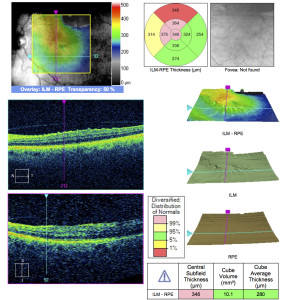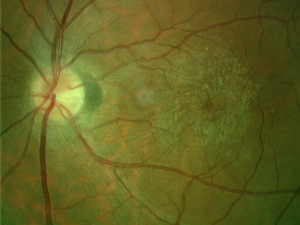Hey, it’s Dr. May again! This month’s topic is a retinal condition called an epiretinal membrane. This is a fairly common retinal disorder that can affect many people, with varying degrees of severity. The retina is the very back layer of the eye, and there are 10 layers to the retina. The very top layer is called the inner limiting membrane, and this is where epiretinal membranes develop. The top layer is supposed to be very smooth and flat, but when you develop an epiretinal membrane, it becomes rough or jagged.The top layer also connects with the vitreous humor (the gel that fills the middle of the eye). Sometimes, the vitreous gel pulls on the top layer, which can cause these epiretinal membranes to develop.
The symptoms of an epiretinal membrane can vary, depending on how jagged or rough the top layer is. Sometimes the vision is unaffected. Sometimes the vision can be very blurry and distorted. Diagnosis is best done with a dilated exam and also an OCT scan (Optical Coherence Tomography). This special testing machine allows us to look specifically at the top layer and see what is happening. We can repeat this test over time to look for changes.

OCT scan of an epiretinal membrane.
The treatment and management of an epiretinal membrane depends on how severe it is. If it is very mild and not affecting vision, then we would just monitor it and watch for changes. If the epiretinal membrane is distorting the vision and making it blurry, then there are some surgical options to fix the epiretinal membrane and smooth out the top layer again. In these cases, we refer to retinal specialists.
We have seen many successful patients undergo surgeries to fix epiretinal membranes over the years! If you are experiencing blurry or distorted vision, be sure to get your eyes checked yearly to make sure it is not an epiretinal membrane. If you have any questions, please let us know, and we look forward to seeing you!
-Dr. May






One thought on “Educational Series: Epiretinal Membrane”